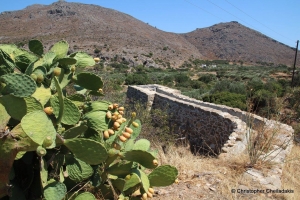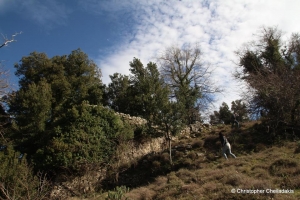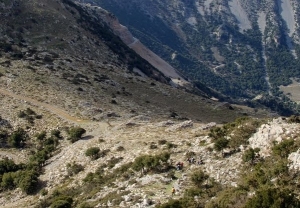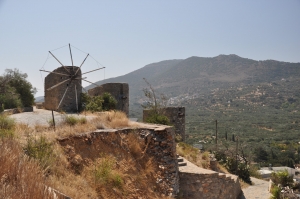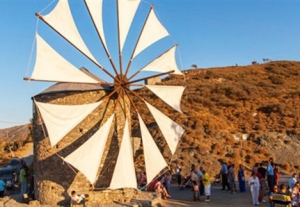Near the settlement of Marnellides, Merambelo district, we still meet one of the many windmill parks of Crete. There are still standing 8 windmills in a row, while a little further up the mountain there is a ninth secluded windmill. . Others survive in good condition and others have collapsed. Marnellides mills are of the more usual windmill type of Crete that turns only in a certain wind and is called Axetrocharis (this has rectangular shape). These mills were used for grinding grain.
Sitia province, because it hosts many springs, hosted several places with watermills. Almost every village hosted one or more mills, unlike most places of Eastern Crete where windmills were used, because of the lack of water. One of the best preserved watermills that is still preserved in a very good condition is the watermill of Chochlakies. Chochlakies is a very small village with a very few residents today at the eastern end of Crete. The watermill of Chochlakies is built on the east end of the village, right on the path that leads to the gorge of Chochlakies and the beach of Karoumes.
East of Limnes village, near Agios Ioannis church, we still meet two of the several windmill parks of Crete. Each park still hosts six windmills in a row (twelve overall), with the roofs being collapsed. These mills are of the more usual mill type, that turns only in a certain wind called Axetrocharis (this has a rectangular shape).
Near the villages of Episkopi and Mourtzana, in a lush green valley, we still see the ruins of the houses and the watermills of the village Mousses or Moussi. In this village we meet the five watermills that took advantage of the abundant water of the area for grinding grain of the surrounding villages. The mills operated till the 1950s, when the modern technology surpassed the traditional way of grinding. Thus, the millers who saw their job diminishing, had to leave this wonderful place and seek their future elsewhere.
One of the mills in Lassithi plateau preserved in quite good condition is the watermill of Plati, located on a slope slightly higher than the village in a wooded location with old oaks, platans and other trees. The watermill in Plati hosts a large stone cistern where water was collected and used later for grinding the grain.
During the battle of Lassithi in 1867, the 10 windmills that stood near Potami village and were mainly used for milling, were destroyed by the Turks. The windmill park was then moved to Katakalou and Asfendami areas, and later moved to the big mill park of Ambelos.
North of Nikithianos village, Merambelo district, we still meet one of the most impressive windmill parks of Crete. There are still standing several windmills in a row. Others survive in good condition and others have collapsed.
Above the village Gonies we meet the beautiful windmill of Manousakis, built in 1904 for grinding grain. The restored mill, fully functional today, ceased its commercial operation in 1988, and it was impossible to overcome the technological development of the time.












